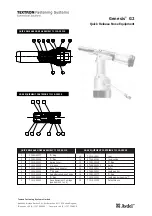
15
Using the Cordless Rotary Tool
Operating Speeds for Accessories
Set the speed indicator to fit the job to achieve the best job results when work-
ing with different materials . To select the right speed for each job, use a practice
piece of material . Vary speed to find the best speed for the accessory you are
using and the job to be done .
Your Cordless Rotary Tool is equipped with a variable speed control dial . To turn
the tool ON, rotate dial to desired number to select the operating speed needed
from 5,000—25,000 RPM . To turn tool OFF, rotate dial to the “0” off position .
Needs for Slower Speeds
Certain materials, however, (some plastics, for example) require a relatively slow
speed because at high speed the friction of the tool generates heat and causes
the plastic to melt . Most work is done at high speed on your Cordless Rotary
Tool . Lower speeds are needed only for
certain tasks .
Ultimately, the best way to determine the
correct speed for work on any material is
to practice for a few minutes on a piece of
scrap . You can quickly learn that a slower
or faster speed is more effective just by ob-
serving what happens as you make a pass
or two at different speed .
When working with plastic, for example, start at a slow rate of speed and
increase the speed until you observe that the plastic is melting at the point of
contact . Then reduce the speed slightly to get the optimum working speed .
Some rules of thumb in regard to speed:
1 . Plastic and materials that melt at low temperatures should be cut at low
speeds .
2 . Polishing, buffing and cleaning with a wire brush must be done at speeds
below 15,000 RPM to prevent damage to the brush .
3 . Wood should be cut at high speed .
4 . Iron or steel should be cut at top speed if using tungsten carbide accessory,
but at slower speeds if using high-speed steel cutters . If a high-speed steel
cutter starts to chatter—this normally means it is running too slow .
Aluminum, copper alloys, lead alloys, zinc alloys and tin may be cut at various
speeds, depending on the type of cutting being done . Use paraffin or other suit-
able lubricant on the cutter to prevent the cut material from adhering to the cutter
teeth .
Increasing the pressure on the tool is not the answer when it is not cutting as
you think it should . Perhaps you should be using a different cutter, and perhaps
an adjustment in speed would solve the problem . But leaning on the tool seldom
helps .
The speed of
rotary tool is
controlled by
rotating this
dial to desired
setting on
dial.




































